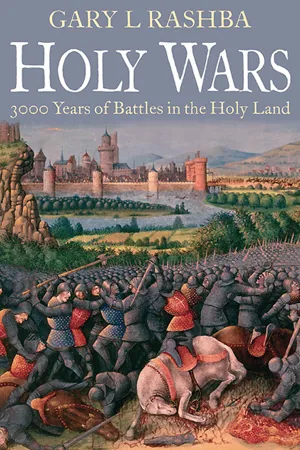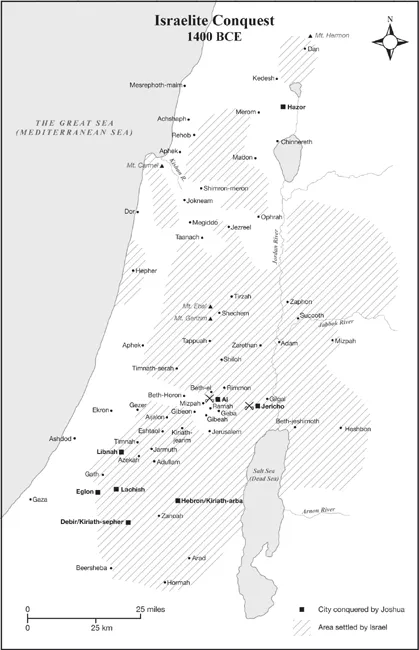![]()
CHAPTER 1
LATCH OF THE LAND OF ISRAEL
ISRAELITE CONQUEST OF THE PROMISED LAND, 1400 BCE
Circling Jericho’s massive walls, the Israelite men had their doubts. Armed with only knives, swords, spears, lances, and bows and arrows, the Israelites had nothing with which to knock down such walls. They also lacked equipment to scale, tunnel, or breach the ramparts. Yet their plan for the conquest of Canaan hinged on first taking Jericho. Looking up at the fortified city’s defenses, some of the men became demoralized and questioned how they could possibly succeed. It was 1400 BCE, and the Israelites were following Joshua to take possession of their Promised Land after spending forty years in the desert.
Bountiful with food and water in an arid, inhospitable land, Jericho was a way-station for caravans and travelers moving between and along the two banks of the Jordan River. A lush green oasis whose palm trees contrasted with the surrounding desolate brown terrain, Jericho was accustomed to attacks by marauding nomadic tribes. The city had gone to great lengths to protect and defend itself:
There was no question that Jericho could hold out against the Israelites. Secure behind its walls, the people of Jericho were con fi dent they could withstand any siege. They had proven it time and again. Not only did the city have strong defenses, it was also wellprovisioned. The Israelites approached the city just after the spring harvest, so the stores were full of wheat, dates and other foodstuffs; and the perennial Spring of Elisha, or Ain es-Sultan, provided ample water. Despite the obvious mismatch, morale in Jericho was low and its people scared. It wasn’t only that recent earthquakes could have damaged the protective walls. There was something different about this enemy. It is very likely that stories about these people who had defied the pharaoh’s power and left Egypt (the power that dominated Canaan), of their crossing the Red Sea and later military victories across the river were known by Jericho’s citizenry, putting them on edge.2
Before the Israelites had crossed the Jordan River into Canaan, Joshua looked across the valley at the lay of the land before him, with Jericho and its defenses visible in the distance. After succeeding Moses, Joshua began formulating a plan for the Israelite advance, bringing to fruition his people’s aspiration to return to the Promised Land, a longing maintained throughout the generations by oral tradition. No newcomer to the battlefield, Joshua had already made a name for himself as a military leader, but planning an invasion was something else. He knew the Israelites lacked the capability to attack the Canaanites’ secure stone-walled cities. His force was also at a disadvantage in open-country warfare against chariot-equipped and heavily armed Canaanites regulars. The Israelites also had to consider the Egyptian reaction, as Egypt claimed suzerainty over Canaan. But with internal problems and troubles on its borders, Egypt could no longer safeguard all of Canaan; its influence was hardly felt on the frontier. The Israelites’ best chance for successfully establishing themselves in Canaan lay in the sparsely populated hills in the center of the country. Later called the “latch of the Land of Israel” in ancient Jewish writings, Jericho controlled the route into the mountainous heartland of Canaan. If they could take Jericho, the Israelites would have a bridgehead west of the Jordan River, a foothold they could expand into a much larger area for permanent settlement.
Requiring intelligence on Jericho’s defenses, Joshua dispatched a two-man reconnaissance team to scout out approaches and the city’s defenses. Jericho’s well-developed defensive network noticed the spies’ arrival. Jericho’s king received a report that Israelite men had come to search out the land.3 The pair of Israelites would gain the confidence of, and lodge with, a woman named Rahab, who provided assistance. When townspeople hunted the two strangers, Rahab hid them and helped them escape. For her actions, Rahab and her family were later spared during the Israelite killing spree.
The reconnaissance report Joshua received indicated disunity in the city, and a fear of the Israelites, whose reputation had preceded them. Armed with this knowledge, Joshua conceived his plan.
United in their purpose of conquering the Promised Land, the Israelite host—ripe for action—set off from their encampment across the Jordan River. Years in the desert, often under attack by other nomadic tribes, had forged them into a hardy fighting force. Encouraged by recent military successes over the Ammonites and King Og, and motivated by their commander, the Israelite soldiers were raring to fight.
They crossed the Jordan River at an easily passable ford. The Book of Joshua states that the river was in flood, but that when the priests carried the Ark of the Covenant to the edge of the river, it stopped flowing until all the Israelites had crossed. Some scholars argue that an earthquake occurred at the time of the crossing and may have caused the steep banks to collapse, damming up the Jordan River for several hours.4 The Israelites crossed over on dry land, until the build-up of water forced through the obstruction. Already instilled with the zeal of God, this was seen as divine intervention, reinforcing their faith.
The appearance and disappearance of the two Israelite spies had alerted Jericho that trouble was literally on the horizon. Walls damaged by recent tremors were hastily repaired. People living outside the city sought refuge within Jericho’s protective walls, and the city gates were closed. From the vantage of their ramparts, Jericho’s defenders now followed the Israelites’ approach. Rumors and talk about the Israelites exacerbated the already tense situation. Morale plummeted as fear took hold in the city, and there was little will to fight. The Jordan River ceasing to flow, allowing the Israelites to cross with ease, was taken by the local people as a very bad omen.
Lacking the means with which to attack the city, Joshua put a different weapon to work: psychological warfare. Led by the Ark of the Covenant, containing the stone tablets inscribed with the Ten Commandments that Moses had received on Mount Sinai, and seven priests blowing rams’ horn trumpets, the 40,000-strong Israelite host set off from their encampment and ap proached the city walls.
Jericho’s defenses sprang into action, reinforcing defensive ramparts and towers. But the Israelites did not attack. They circled Jericho’s walls, parading around the city in a huge procession. After completely circling the city once, the Israelites retired to their nearby camp.
For the next five days, the Israelites repeated this drill, marching around the walls once before returning to camp. Jericho’s defenders were wary and suspicious, amused and frightened by these strange desert nomads’ unusual procession around their city. There were no demands from the Israelites; the siege was anything but conventional. Blasts of the Israelite priests’ rams’ horns sowed fear among the besieged city’s inhabitants, who were discomfited by the sight of an army laying siege to their city. Unsure how to respond, Jericho’s defend ers made no sallies against the Israelites.
On the seventh day of the siege, as the Israelites were completing their circuit, blasts from ram’s horns signaled a change: the Israelites were to continue circling the city. The Israelites circled a second time. Then a third. And a fourth.… Jericho’s nervous apprehension turned to fear as what had become habit veered to the unknown. With each additional lap around their city, the feeling of impending doom among the defenders grew. The noose was slowly tightening. Many prayed to Reshef, the Canaanite god of war.
After circling the city seven times, the Israelite priests blew the rams’ horns, making a great noise, and the men began to shout. The ground began to shake, and a rumbling sound could be heard, growing louder and louder. The noise grew in intensity as stones and bricks began to dislodge from the wall’s upper portions. Cracks appeared and grew larger, growing into large fissures until the great stones at the base broke free and rolled down the slope, kicking up a thick cloud of brown dust. In several places, the mud brick city wall collapsed down onto the retaining wall, forming a ramp. During her 1950s excavations, the late British archaeologist Kathleen Kenyon found “fallen red bricks piling nearly to the top of the revetment. These probably came from the wall on the summit of the bank.”5
The Israelite troops rushed up the earthen embankment, over the collapsed walls and into the city. Shocked by the tumultuous collapse of the walls and their sudden vulnerability, the townspeople were overcome with terror and became paralyzed by fear.
From pessimistic doubts to what they now saw as divine intervention, the Israelites were imbued with religious fervor, faith in their mission restored. So inspired, they rushed through Jericho’s streets freely killing everyone in sight. Townspeople fled among the streets and alleyways; others tried to hide. The invaders ran through the town with gusto, euphorically killing man and beast alike. Jericho’s fighting men hardly resisted, and many people merely submitted themselves to slaughter by the rampaging invaders:
Joshua had ordered his men to completely exterminate Jericho’s population, and this order was carried out without exception. Save for the pledge made to Rahab, the Israelites “utterly destroyed all that was within the city by the edge of the sword.” The city was not plundered; it was destroyed and set on fire.
“The destruction was complete,” wrote archaeologist Kathleen Kenyon. “Walls and floors were blackened or reddened by fire, and every room was filled with fallen bricks, timbers, and household utensils.…”7 While the level of destruction and killing may seem excessive, the Israelites knew their arrival posed a true threat to all Canaanites, who might very well have taken the opportunity to wipe out this new force in their midst. And with plans to advance into, and establish themselves in, the Canaanite hinterland, their actions at Jericho were preemptive—killing off enemies who could threaten their rear while also establishing a reputation for ferocity. Jericho was left unoccupied and cursed, and the Israelites moved on.
While archaeological evidence over the last century corroborates the Bible’s version of a fortified city destroyed after a short siege, its walls collapsed and the city wrecked by fire, the debate continues over when this occurred. Kenyon and others date Jericho’s destruction to 1550 BCE—too early for the aggressors to have been Joshua and the Israelites. Challenging Kenyon’s methodology, contemporary archaeologist Bryant Wood dates Jericho’s destruction to 1400 BCE, which aligns with the timing of the Biblical account. Further debate surrounds the arrival of the Israelites to Canaan, with many scholars believing the Israelites arrived some 200 years later—in 1200 BCE—long after Jericho was destroyed.
Ai
… take all the people of war with thee, and arise,
go up to Ai; see, I have given unto thy hand the king
of Ai, and his people, and his city, and his land.
Joshua 8: 1



